We have completed our review of the Long Beach City Auditor's report and are dismayed to see how bad it is for Long Beach's shelter animals.
0 Comments
 Just this week, the Long Beach auditor released the audit of Long Beach Animal Care Services that was requested by the mayor, after three years of continued pressure from Stayin' Alive and other concerned citizens in Long Beach. Stayin' Alive is currently reviewing the report and will have a comprehensive analysis of it in the coming days. A preliminary review shows that the report makes many of the recommendations Stayin' Alive has made repeatedly over the past 4 years, including those made in two comprehensive research reports. However, there are at least two items that give cause for concern, which we'll preview for you now. Massive Loophole for the City: One problem that is immediately clear is that many of the recommendations that the report makes are for "Best Practices." These Best Practices, according to the Auditor's office "may not be possible in all circumstances." This leaves a massive loophole for Mayor Garcia and the City to fly through -- and disregard those practices. It is clear that the animal community in Long Beach will need to continue to monitor, and (given the City's historic unwillingness to act) more likely pressure, the City to make sure the Best Practices are followed. We'll have more on whether those Best Practices are truly "Best Practices" in coming days. The Problems with SpcaLA Get Last Priority: The report also classifies recommendations into Short-Term and Long-Term recommendations. The Auditor has made a clarification of the troubled relationship between Long Beach Animal Care Services and SpcaLA a "Long-Term Recommendation." This relationship, which has resulted in the killing of tens of thousands of animals over the past 19 years, has been disastrous to shelter animals in Long Beach since the lease agreement between SpcaLA and the City was forged back in 1998. Long Beach shelter animals have been in drastic need of a reform of the toxic partnership between the two entities for nearly two decades. The current agreement is slated to be in place until 2053. Depending on how the City defines "Long-Term," this recommendation could be all but meaningless, and stretch until 2053 or longer, meaning our shelter animals will continue to be killed needlessly. This is not surprising; JVR Shelter Strategies, the consultants hired by the City to work on the audit, is not aligned with the concept of No Kill. Their website lists consultation on "euthanasia practices" as a service they offer, but nothing about adoption programs, foster programs or other lifesaving programs that shelters -- especially Long Beach Animal Care Services -- need to have. We'll have more on the report in the next few days, but we encourage all of you to: 1. Read the report; 2. Evaluate it in terms of how it serves or does not serve our shelter animals, and the animal-loving community and taxpayers of Long Beach; and 3. Speak up for our shelter animals to your City Council member and at City Council meetings. Read the Auditor's Report here: bit.ly/acsro Read the three things you need to know about the auditor's report here:https://goo.gl/v9V8h4 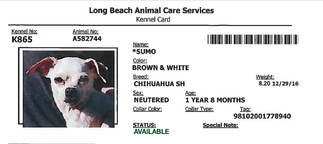 In a recent e-mail to Stayin’ Alive Long Beach, the Long Beach Auditor’s office has once again confirmed that Phase One of the audit of Long Beach Animal Care Services is due out by the end of the year. As part of the data-gathering process, the Auditor's office received input from members of the public. Stayin’ Alive was among those who gave input. As many of you know, our input is based on our research, which utilizes data from LBACS obtained through the California Public Records Act. One of the animals we told the Auditor about was a little dog named Sumo. Today we are going to tell the story of Sumo on this page – a chihuahua who entered LBACS in December 2016 with his siblings and was burned over large portions of his body while at LBACS. Sumo entered LBACS on December 6, 2016. His notes say he was “skittish and scared,” most likely because he had been separated from his siblings. Shelters are stressful for animals, so this is not surprising. According to LBACS records, on December 14, the neighboring SpcaLA “passed” on Sumo – meaning they declined to take him in -- because of his behavior. He was fearful, LBACS records state. Two days later, on December 16, not surprisingly, Sumo started coughing and sneezing, which is always bad news for animals at LBACS. Because there is no adoption program at LBACS (because Mayor Garcia now allows SpcaLA to do the vast majority of adoptions, rather than having a strong adoption program run by LBACS) animals get sick at LBACS every month and are killed. LBACS director Ted Stevens justifies these killings, saying that they are not done for time and space but because the animals are ill. However, the part that is consistently left out is the fact that LBACS is the one that made them sick by not having an adoption program that gets animals into homes quickly. Luckily for him, Sumo bounced back from his cold, but on January 4, he was dealt another cruel blow: a note in his record states that SpcaLA “will no longer show dog” because of his behavior. Again, he was fearful, which is not surprising for a small dog who is scared and stressed in an animal shelter. Finally on January 9, more than a full month after he arrived at LBACS, a potential adopter was found. Things were looking up for little Sumo. But right before he was to be adopted, something happened that introduced a harrowing, painful period in little Sumo’s life. On January 11, seemingly out of the blue, Sumo’s record notes that there were “large areas of erythema” (redness due to injury) across his body that was suspected to be a “thermal burn.” Sumo’s LBACS records don’t state how the burn happened. All we know is that there were no burns noted in Sumo’s records when he came into LBACS, and suddenly, on January 11, more than a month after he arrived at LBACS, he had severe burns to large portions of his body. Make no mistake: Sumo’s burns were severe, covering large areas of his body. His LBACS record notes that the burns required “surgical repair.” We can only imagine how painful this was for little Sumo. Scared, sick, rejected and finally somehow burned -- the records don't say how -- while at the shelter. It was amazing that Sumo survived. Sumo’s story is the story of a shelter that is broken and that needs reform. We have told the Auditor about Sumo’s story, as well as other animals’ stories – stories that clearly show that LBACS is in dire need of reform. We have also presented data about the programmatic problems at LBACS, including the lack of an adoption program, lack of a foster program, the problematic and non-transparent nature of LBACS’ relationship with SpcaLA and the large numbers of animals that are killed as a result of this lack of programs. We sincerely hope that the Audit will address these issues and that city officials, many of whom are coming up for re-election in April, will take decisive, much-needed action to improve the Long Beach animal shelter. The good news is that after he was burned while at LBACS, Sumo was eventually taken to an outside vet – by a rescue, not by LBACS. His wounds were treated, and he was adopted. But he went through so much unnecessary pain, sadness and rejection to get there. Let’s be clear. What happened to Sumo is negligent, inhumane and wrong. And it happened at the LBACS shelter. It happened at OUR shelter. Long Beach deserves a reformed shelter that truly commits to lifesaving. Please be a voice for the animals - let your city council member know you want major reforms at the LBACS shelter. Our shelter animals deserve better. Charlie had a horrific stay at the Long Beach Animal Care Services shelter and was killed because of a "behavioral" issue that LBACS itself caused. These facts come directly from LBACS' shelter records. 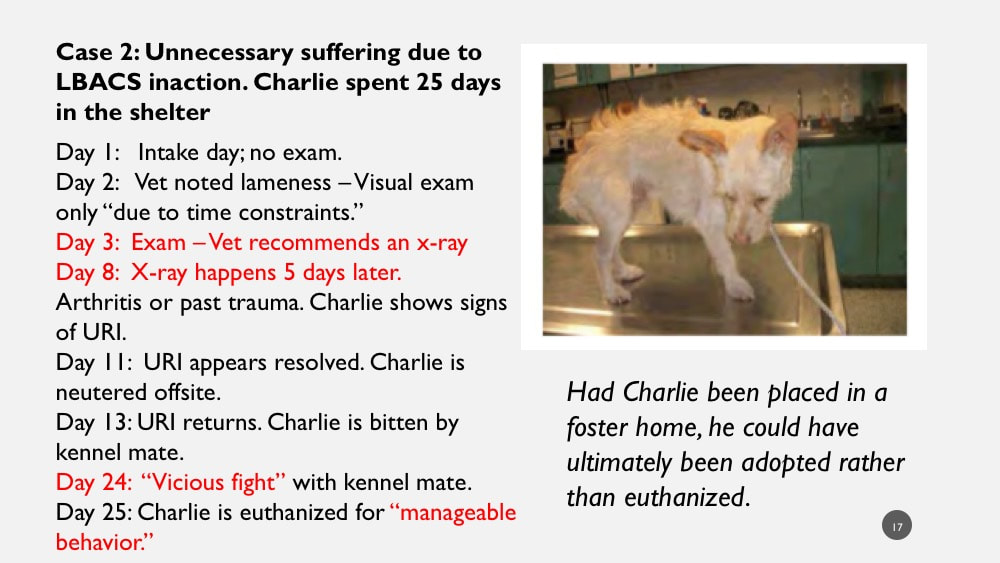 This should not be happening in a city as animal-friendly as Long Beach. We know there is NO way the good people of Long Beach would ever want animals to suffer at our animal shelter the way Charlie did. The auditor knows about cases like Charlie - this slide is part of the PowerPoint presentation we gave to the (non-No Kill) shelter consultants the City hired. Long Beach needs a strong adoption program at LBACS. It's not rocket science. It's just the right thing to do. How has the City's/Mayor Garcia's plan to increase adoptions by passing almost all adoptions over to SpcaLA worked? The graph below shows that since SpcaLA started processing the majority of adoptions at LBACS, the number of adoptions processed by LBACS has actually DECREASED. With a "friend" helping them, they should at least be doing as many adoptions as they were before, with the added benefit of a few more adoptions being done because of SpcaLA's help. With SpcaLA using "boutique-style" adoption policies that cherry-pick homes and impose unreasonable requirements on the public, adoptions at LBACS are still dismally low. A robust adoption program is not expensive. Lives could be saved by instituting even the small change of shifting the open hours of the shelter to 11:30 - 7:30 so people can go to the shelter to adopt after work.
But LBACS continues to resist because of political pressure from SpcaLA (we were told this by LBACS manager Ted Stevens early in our advocacy). The pressure point? To let SpcaLA be the adoption portal and leave the rest over at LBACS to languish in cages with a weak, poorly-managed, half-hearted adoption program that fails them repeatedly. This is the "unique" partnership we have in Long Beach. It's unique because it's a mega-million, big box private "non-profit" tail wagging the city's dog with disastrous consequences for our shelter animals. Find your voice, Long Beach. Go to City Council and demand the (often low-cost) changes and commitment that other cities have made to reach No Kill. Our shelter animals need YOU to be their voice.  It’s budget season at City Council, and there has been a lot of talk recently about whether Long Beach Animal Care Services should have its budget increased. We at Stayin’ Alive have nothing against a shelter getting more money to do its job, generally speaking – provided that they’re doing their job right. The many problems we see day in and day out at LBACS, sadly, have NOTHING to do with budget. We have been advocating for many years for free and easy changes that LBACS could make that would improve their adoptions. Here are some changes that would cost little to no money. In cases where a change would incur costs, there are things that can be done to offset them. **Include after-work hours for adoptions. Currently, you can’t adopt an LBACS animal after 5 pm on weekdays. This makes it extremely difficult for people who work to get to the shelter and adopt. Changing hours to 11:30 am – 7:30 pm (or a similar schedule) costs ZERO money and would save lives. **Expanding offsite adoptions, having adoptions in multiple locations throughout the week so that the public has greater access to the animals, which results in more adoptions and more lifesaving. **Enlisting the help of local businesses in lifesaving. Ask a large local business if they’ll partner with the shelter, either to sponsor a big adoption event. Better yet, ask a large local company (of which LB has many) if they’ll partner with the shelter on an adoption AT the company’s site. These options can be sponsored by the company as part of their mission to give back to the community. If the shelter has a strong volunteer program (as it should), these lifesaving promotions would cost almost ZERO money. **Asking local businesses to sponsor adoptions, making them low to no-fee for a weekend or particular adoption event. ZERO cost to the City; tons of goodwill and great advertising for the company. **Applying for grants (e.g., from PetCo) for things the shelter needs to care for animals, like dog yards so dogs are happy, socialized and ready to go to homes. WHATEVER need the shelter has – not just dog yards – can be financed in this way. Again, ZERO money. **Having a strong volunteer program to do daily off-site adoption programs. If one staff member’s position is dedicated to being a volunteer coordinator, the time spent on training and coordinating volunteers will more than pay for itself in valuable volunteer hours provided by animal lovers in the community. Again, ZERO cost with a net increase in labor in the tens of thousands of dollars. **Having a strong donation program. In 2015, Sacramento Animal Care Services brought in $500,000 in donations. They used this for a variety of lifesaving programs, including additional staff for offsite adoptions, diagnostic tools for blood work, and more spay/neuter surgeries. How do we know that all of these things can be done? Because Sacramento Animal Care Services has done almost every single one of these things AND did over 5400 adoptions in 2016. LBACS did an incredibly low 579 adoptions and killed nearly 1700 animals. Giving more money to LBACS without having lifesaving changes in place will just allow a resistant, unreformed, poorly-managed shelter to squander more of LB taxpayers’ newly-increased taxes to continue to engage in sheltering malpractice. Our shelter animals deserve better. Go to City Council and tell them what we need is NOT to throw more money at our shelter, but to introduce reforms, many of which are low to no-cost, that are MUCH needed at the LBACS shelter. Inform – Educate – Advocate! 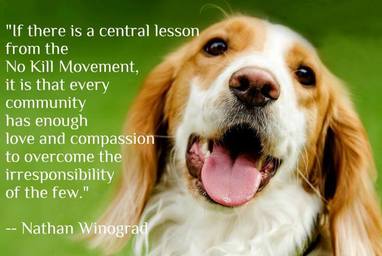 How do you know when someone rejects the No Kill approach to animal sheltering? They talk about the following: ***Punishing the "irresponsible public" instead of looking for ways of making shelters into true safe havens (because the irresponsible public will ALWAYS be with us - we need safe havens NOW)*** ***Strict enforcement of animal laws without talking about engaging the public in lifesaving, compassion and saving lives*** ***Restrictive adoption criteria instead of reasonable, education- and conversation-based adoption processes*** ***Saying No Kill shelters cause suffering by "never euthanizing" (which is not true) instead of talking about the crucial distinction that No Kill makes between euthanizing and killing. Euthanasia is a merciful release from irremediable suffering and must be done to stop suffering when that suffering cannot be relieved. Taking an animal's life when he is healthy should be called what it is -- Killing. ***Saying Spay/Neuter is the "ONLY" way instead of recognizing the many different programs / angles / process that progressive shelters can and are currently engaging in to save lives. Neuter and Spay is ONE way and one way ONLY. We need to hit the problem from ALL angles. ***Saying No Kill shelters hoard animals, rather then understanding that No Kill shelters actually create plans and pathways to get animals out of the shelter as soon as possible.*** Sometimes people make these arguments because it's what they've been told for many years. But when they hear about how No Kill **really** works, they understand and change their messaging. Other people resist the No Kill approach. These are the people who are invested in the broken shelter system, have made it work for them, and want to keep it that way. It's important to know the arguments that people make against No Kill so you can spot who is for the animals and who is for keeping things exactly the same as they've always been. What is No Kill? No Kill is LOVE. 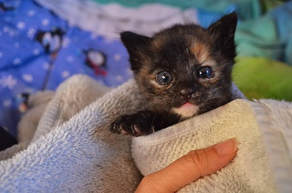 Today is NBC's "Clear the Shelters" day in Southern California, and apparently, both LBACS and SpcaLA are participating. But while other shelters in the Southland are going to do large numbers of adoptions into wonderful homes and save many lives, we anticipate that the number of animals that will be adopted at LBACS will be fairly low. This is because SpcaLA, courtesy of Mayor Garcia and City Manager Pat West, has been allowed to take up all of the real estate on these events. The animals at SpcaLA will be the first to be considered by the public, with LBACS animals getting second priority. How do we know this? The media coverage on this is dominated by SpcaLA. When we opened the video below, we thought we'd see Ted Stevens from Long Beach Animal Care Services speaking because the video title says "Things to Know Before Adopting at the Long Beach Animal Shelter." Instead, it's the SpcaLA manager talking about "When you adopt from SpcaLA" and "Adoptions at SpcaLA." Notice it's not "When you adopt from the Long Beach animal shelter." There's a difference. One highlights Long Beach animals. The other highlights SpcaLA as the adopting agent. Another point to mention: SpcaLA makes it hard to adopt from them. Other progressive shelters and national organizations have moved to a program of "Open Adoptions," by which potential adopters are screened via application and interview and are educated about how to be a responsible pet guardian. SpcaLA really wants to put you through your paces. To adopt from SpcaLA, you have to bring, not only your ID, your compassion and a willingness to give a good home to an animal, but also: - A copy of your lease, - The phone number for your landlord, apparently for a phone check on whether your lease is accurate - Every member of your household and - Your dog, if you have a dog These excessive requirements are now recognized by national welfare organizations such as HSUS and ASPCA as unnecessary and a hindrance to adopting. So while we're happy that some animals will be adopted into loving homes today - it won't be as many as it should be, and the animals who are most at risk, at LBACS, will still remain second class citizens. Come Monday, animals will be killed who would have been adopted out today in a more progressive shelter system. Watch the video here: http://www.nbclosangeles.com/…/Clear-the-Shelters-How-to-Pr… #Cleartheshelters  City Council’s discussion around animals was brief at last Tuesday's meeting, in spite of the fact that a number of people spoke during public comment on the budget presentation by Parks, Recreation and Marine, the city department which houses Long Beach Animal Care Services. Parks, Recreation and Marine head Marie Knight kept her comments about LBACS brief, recycling LBACS’ inaccurate mid-year numbers and talking about LBACS’ progress in reducing “the unwanted pet population.” The issue of the inaccurate numbers aside (Stayin' Alive has written a report about LBACS' inaccurate reporting practices, which can be found here: https://goo.gl/sDgNZP), we’d like to point out that words matter. The use of the term “unwanted pets,” by the head of Parks and Rec to describe our shelter animals perfectly encapsulates the deficit view that City administration has of our shelter animals, and it is this negative and pervasive view that keeps our shelter animals suffering in a broken shelter system. We can only hope that through education about how other cities are saving lives through No Kill programs, this view will change. Knight ominously warned that recent increases in the save rate at LBACS “may plateau” if the City doesn’t invest further in space and “intervention resources.” It’s unclear what was meant by intervention resources, but one thing we do know: The City only needs more space because it warehouses animals for far too long, and does so because there is no strong adoption and foster program. This often results in inhumane treatment of animals and points to much bigger issues than simply “space.” Knight also talked about two new positions requested for LBACS in the next fiscal year. New positions are all well and good, but without a strong framework of programs in place, and a change in culture, these types of cosmetic changes, even if they come in the form of new positions or more money, will not make a difference. The sadly remarkable thing about the evening was the apparent lack of interest most of the council members showed in the comments of those who spoke on behalf of the animals. After public comment, city council members have an opportunity to ask questions about the budget presentations by city staff. After listening to almost 40 minutes of public comment, the vast majority of which was about shelter animals, here is how the City Council members responded: Vice Mayor Rex Richardson, District 9: Deferred questions to a later date. No questions about LBACS or shelter animals in council. Lena Gonzalez, District 1: No questions about LBACS or shelter animals Susie Price, District 3: No questions about LBACS or shelter animals Daryl Supernaw, District 4: No questions about LBACS or shelter animals Dee Andrews, District 6: No questions about LBACS or shelter animals Roberto Uranga, District 7: No questions about LBACS or shelter animals Al Austin, District 8: No questions about LBACS or shelter animals Mayor Garcia was notably absent. The only two councilmembers who addressed in any way the issue of our shelter animals were Stacy Mungo, District 5 and Jeannine Pearce, District 2. Stacy Mungo brought up two points, which to our knowledge have never been publicly acknowledged by a city council member, though many of them have known about it for years. The first was the question of how to address the many problems caused by the City’s troubled 19-year partnership with SpcaLA, which has been absolutely disastrous for Long Beach’s shelter animals. This was the first time to our knowledge that the stranglehold the City administration allows SpcaLA to have on LBACS has ever been acknowledged. We hope, for the sake of the animals, it won’t be the last. Second, Stacy Mungo asked her colleagues if they would be open to an ordinance that would have an impact on the problems at LBACS. She was not specific about what such an ordinance would look like, but Stayin’ Alive has long advocated for an ordinance similar to that passed by the City of Austin, which resulted in that city’s being the nation’s largest municipal shelter to reach and maintain No Kill status. We will be monitoring any ordinance development that may occur going forward and offering our input. You can read Stayin' Alive's model ordinance here: https://goo.gl/x9qozK). Jeannine Pearce, who Stayin’ Alive supported in the last election, also spoke about issues at LBACS, asking Knight about the possibility of a presentation by LBACS about exactly how it runs its programs and operations. Significantly, Jeannine Pearce noted that it may be time to ask what kind of shelter we want to be, which speaks to an interest in a deeper look at LBACS. This is a departure from how city council members have behaved in the past, preferring instead to perpetuate the myth that LBACS is doing great. More importantly, she also admitted to having spoken to Sacramento Animal Care Services and the Austin Animal Center (Stayin’ Alive specifically asked Jeannine Pearce through a series of meetings to contact Sacramento and Austin to find out about the programs they put in place and how Austin was able to reach No Kill – we’re happy to hear that she followed through). In the end, the facts remain: it’s not about money, and it’s not about space. It is most definitely not about asking SpcaLA to take more animals in, given that SpcaLA opposes No Kill and is not accountable to the public. It’s about changing the culture at LBACS and passing an ordinance that codifies LBACS’ priorities and requires it to put in place lifesaving programs. While we see faint glimmers of that from time to time, this time provided by Jeannine Pearce and Stacy Mungo, it is clear that much more advocacy remains to be done by Long Beach animal lovers to ensure that our shelter is a safe place, where they are truly sheltered from the storm of human whim and circumstance. We encourage all community members in Long Beach to share your voice at the next City Council meeting. Our shelter animals need ALL of us to be their voice.  When we first began advocating for No Kill in Long Beach five years ago, a very small group of people started grumbling that No Kill actually meant "never euthanize" and led to animal cruelty and warehousing of animals at shelters. Of course, nothing could be further from the truth, and we soon cleared that up, speaking at City Council to clear up ANY misunderstandings whatsoever. We'll take a moment to do that again here on this page today. To first address the mistaken idea that animals are not euthanized when they are suffering under No Kill: This is completely, totally and unequivocally INCORRECT. No Kill absolutely believes in euthanasia of animals that are suffering and are past help. In those cases, euthanasia is humane and necessary to relieve irremediable suffering. However, if an animal is deemed treatable by a veterinarian, euthanasia is not appropriate: Treatment is. No Kill makes a very clear distinction, then, between killing, which is the taking of the life of animals that are healthy or treatable, and euthanasia, which is the taking of the life of an animal when it is irremediably past help. That's the No Kill stance on euthanasia, but what makes No Kill an eminently effective approach to sheltering is No Kill's emphasis on having a secure, stable and reliable system in place, in the form of programs, that 1) supports the public to keep animals out of the shelter if possible, and 2) gets animals out of the shelter as quickly as safely possible once they're in. People who bring up completely erroneous definitions of No Kill are generally attempting to discredit it as a movement. They are disgruntled people in the sheltering profession who invested their time and effort into a broken system and basically bought into the idea that you can only save some of the animals some of the time, and have to kill the rest. Some of them have found ways to make significant amounts of money through this broken system and see No Kill as a threat to their revenue stream. This is enough for them to fight innovations in animal sheltering tooth and nail, in spite of the fact that in doing so, they are advocating for the unnecessary killing of animals. The solutions to animal killing in our shelters that originated in the No Kill movement are being implemented successfully in shelters across the nation. If it's being done by other shelters, it can be done, and opposing the programs that No Kill advocates for is both irrational and harmful for animals. No Kill is a movement whose time is here. The animals have waited long enough for humane shelters that offer lifesaving instead of death. It is absolutely certain that the majority of shelters in this country will one day be No Kill shelters, and we'll look back on this dark time in our history and wonder how people could have ever argued against it. Be on the right side of history - advocate for our shelter animals. Know what No Kill REALLY is, and spread the word. INFORM - ADVOCATE - EDUCATE - SHARE |
Archives
June 2022
SALB
An initiative to make Long Beach a No Kill community. Categories |
No Kill Long Beach
- Home
- ::NKLB in the News::
- 2020 Voter Information Guide
- How you can help
-
Get Informed
- Contact Us
- LBACS's Numbers
- Model No Kill Ordinance
- LB City Officials' Contact Info
- No Kill Long Beach Blog
- Justice for Thor
- LBACS Complaints
- A Shelter in Crisis
- 2018 Candidates' Responses
- LBACS Document Archive
- Why "Compassion Saves" is No Good

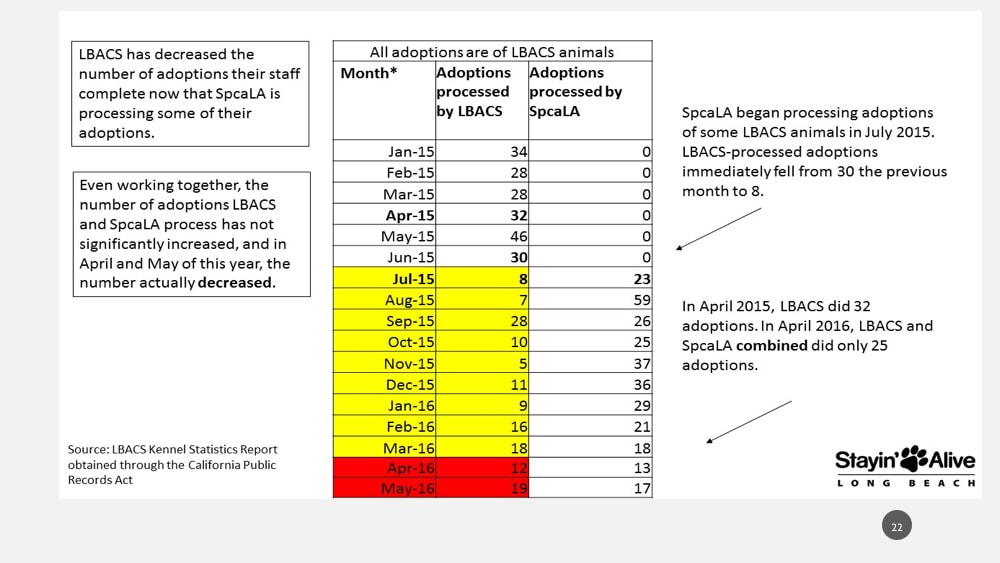
 RSS Feed
RSS Feed
